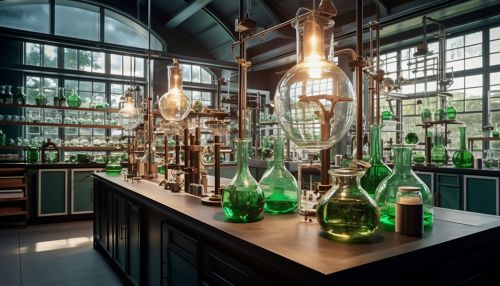Green Chemistry
Introduction
Green chemistry, also known as sustainable chemistry, is a scientific discipline that focuses on the design of products and processes that minimize the use and generation of hazardous substances. The field is a response to the need for environmentally friendly chemical practices, and it aims to reduce the negative impacts of chemistry on the environment and human health. Green chemistry is an interdisciplinary field that involves aspects of organic chemistry, inorganic chemistry, biochemistry, analytical chemistry, and physical chemistry.


Principles of Green Chemistry
Green chemistry is guided by twelve principles, known as the 12 Principles of Green Chemistry. These principles provide a framework for scientists and engineers to design or redesign sustainable chemicals, materials, products, and processes.
1. **Prevention**: It is better to prevent waste than to treat or clean up waste after it is formed. 2. **Atom Economy**: Synthetic methods should be designed to maximize the incorporation of all materials used in the process into the final product. 3. **Less Hazardous Chemical Syntheses**: Wherever practicable, synthetic methodologies should be designed to use and generate substances that possess little or no toxicity to human health and the environment. 4. **Designing Safer Chemicals**: Chemical products should be designed to affect their desired function while minimizing their toxicity. 5. **Safer Solvents and Auxiliaries**: The use of auxiliary substances (solvents, separation agents, etc.) should be made unnecessary wherever possible and, innocuous when used. 6. **Design for Energy Efficiency**: Energy requirements should be recognized for their environmental and economic impacts and should be minimized. Synthetic methods should be conducted at ambient temperature and pressure. 7. **Use of Renewable Feedstocks**: A raw material or feedstock should be renewable rather than depleting whenever technically and economically practicable. 8. **Reduce Derivatives**: Unnecessary derivatization (blocking group, protection/deprotection, temporary modification of physical/chemical processes) should be minimized or avoided if possible, because such steps require additional reagents and can generate waste. 9. **Catalysis**: Catalytic reagents (as selective as possible) are superior to stoichiometric reagents. 10. **Design for Degradation**: Chemical products should be designed so that at the end of their function they break down into innocuous degradation products and do not persist in the environment. 11. **Real-time Analysis for Pollution Prevention**: Analytical methodologies need to be further developed to allow for real-time, in-process monitoring and control prior to the formation of hazardous substances. 12. **Inherently Safer Chemistry for Accident Prevention**: Substances and the form of a substance used in a chemical process should be chosen to minimize the potential for chemical accidents, including releases, explosions, and fires.
Applications of Green Chemistry
Green chemistry has a wide range of applications in various fields, including pharmaceuticals, polymers, and energy production. In the pharmaceutical industry, green chemistry practices can lead to the development of safer, more efficient drugs. For example, green chemistry principles can be applied to the synthesis of pharmaceuticals, reducing the amount of waste produced and making the process more efficient.
In the field of polymers, green chemistry can be used to create safer, more sustainable materials. For example, biodegradable polymers can be created using green chemistry techniques, reducing the environmental impact of these materials.
Green chemistry also has applications in the field of energy production. For example, the development of renewable energy sources, such as solar and wind power, can be guided by green chemistry principles. These energy sources are more sustainable and have less of an environmental impact than traditional fossil fuels.
Challenges and Future Directions
While green chemistry offers many potential benefits, there are also challenges to its widespread adoption. One of the main challenges is the need for education and training in green chemistry principles and techniques. Many chemists are not familiar with green chemistry, and there is a need for more education and training in this area.
Another challenge is the need for more research and development in green chemistry. While there have been many advances in the field, there is still much to learn. More research is needed to develop new green chemistry techniques and to improve existing ones.
Despite these challenges, the future of green chemistry looks promising. As more people become aware of the environmental and health benefits of green chemistry, it is likely that the field will continue to grow and evolve. With continued research and development, green chemistry has the potential to revolutionize the way we produce and use chemicals, leading to a more sustainable and healthy future.
